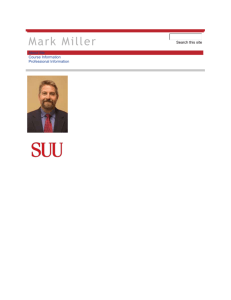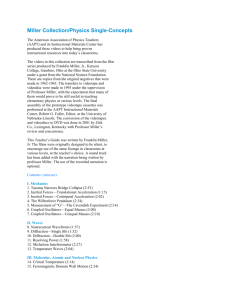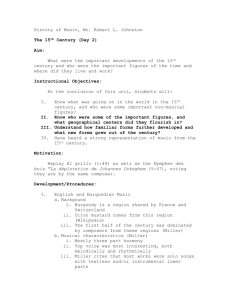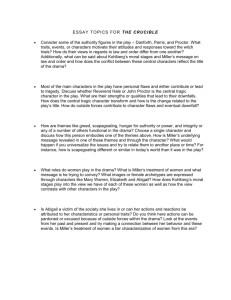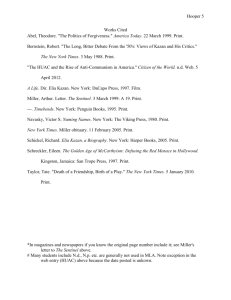Miller Chapter 2 - Economics, Politics, Ethics, Sustainability
advertisement
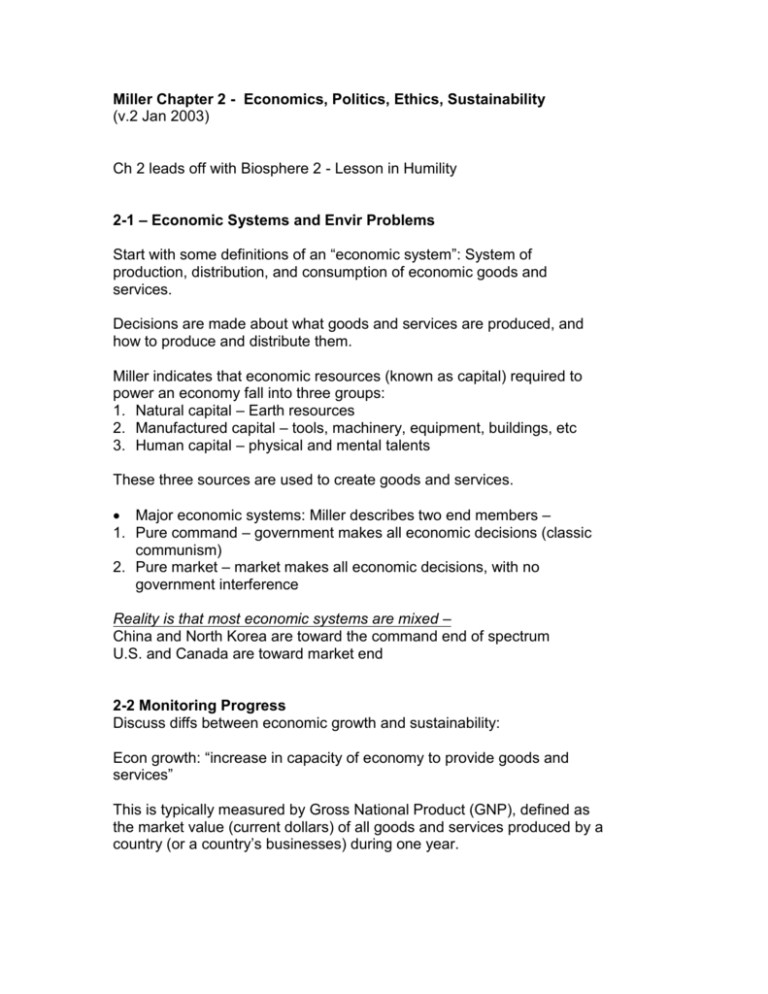
Miller Chapter 2 - Economics, Politics, Ethics, Sustainability (v.2 Jan 2003) Ch 2 leads off with Biosphere 2 - Lesson in Humility 2-1 – Economic Systems and Envir Problems Start with some definitions of an “economic system”: System of production, distribution, and consumption of economic goods and services. Decisions are made about what goods and services are produced, and how to produce and distribute them. Miller indicates that economic resources (known as capital) required to power an economy fall into three groups: 1. Natural capital – Earth resources 2. Manufactured capital – tools, machinery, equipment, buildings, etc 3. Human capital – physical and mental talents These three sources are used to create goods and services. Major economic systems: Miller describes two end members – 1. Pure command – government makes all economic decisions (classic communism) 2. Pure market – market makes all economic decisions, with no government interference Reality is that most economic systems are mixed – China and North Korea are toward the command end of spectrum U.S. and Canada are toward market end 2-2 Monitoring Progress Discuss diffs between economic growth and sustainability: Econ growth: “increase in capacity of economy to provide goods and services” This is typically measured by Gross National Product (GNP), defined as the market value (current dollars) of all goods and services produced by a country (or a country’s businesses) during one year. Big debate occurring over the level of economic growth that world currently experiences. Miller stakes out one side as those who wish for unlimited economic growth. He implies that these people (“most economists, investors, and business leaders") are shortsighted and believe that Earth has plenty of resources, and man is capable of overcoming resource shortage and environmental problems. The other side he stakes out are those who believe that the concept of sustainable economic growth is “nonsense”. They base this belief primarily on their presumption that natural capital will run out in the long run, and nothing will be able to be produced without this natural capital. So where is the middle ground? According to D. Meadows, one possibility is to engage in “smart development”, not “dumb growth”. This makes some sense to me….. Next, Miller criticizes GNP and GDP as poor indicators of human welfare. Remember, these indicators are recognized throughout the world as standards for measurement of economic growth; Miller is arguing that economic growth = human welfare He is on really thin ice here…millions of people all over the planet aspire to have the kinds of lives that US citizens enjoy, life that has been built upon economic growth. Miller is suggesting this all needs to be rethought, very carefully. He has some complaints about certain costs to the environment that are not factored into economic growth calculations. Specifically: Negative environmental effects from producing goods and services Loss of natural capital No benefit shown for energy efficiency Doesn’t show economic justice statistics Miller argues for new indices for growth, that subtract costs and effects associated with pollution, etc from the GNP. He gives several examples: NEW – Nordhaus and Tobin NNP – Repetto et al ISEW – Daly et al GPI – no source cited – Fig 2-5 Miller states that “many economists agree” that these indices are more accurate measures of life quality and environmental quality than GNP & GDP My advice here – be careful to just believe what some textbook author tells you to believe. Assignment 1 - Choose any one of the above 4, find the original work, research it, write about it (250 words). Due in one week. Are these really better indices for measuring human welfare than GNP? Why or why not? 2-3 Solutions: Using economics to improve environmental quality Miller introduces the concept of “full-cost pricing”. Here, he suggests a scenario where producers are “encouraged or forced” to include all costs, both internal and external, of goods and services. The idea here is to make it more economic to prevent pollution and hazardous working conditions than to just let the status quo remain in effect. Over the course of several decades, Miller believes this new economic system, more suited to sustaining natural capital, could take root and develop. Interesting concept……. On to cost-benefit analyses – Miller suggests that traditional costbenefit analyses do not adequately factor in hidden environmental costs that ultimately cost all people one way or another (eg, money or good health), and are thus misleading. Spotlight article makes good point about discount rate. Many things, due to inflation, tend to depreciate in terms of today’s dollars, so discount rate is designed to compensate for that. But problems arise when trying to weigh the costs, for example, of cutting down Redwoods for timber. These trees could be worth MORE in the future, not less. What about Regulations vs Market Forces to promote change? Regulation is primary mechanism today to enact environmental protection, but also some studies indicate that companies can improve profitability through increased innovation and efficiency in environmental management. Miller suggests that market forces can certainly be tweaked in order to get more desirable environmental outcomes. Example: utilize government subsidies to encourage “earth-sustaining” behavior, rather than “earth-degrading” behavior. Another concept: tradable pollution rights. Set a maximum limit, dole out permits, those who can pollute less can sell their credits to those who pollute more. So those who pollute less make more money. Another concept: “green” or “effluent” taxes, which would prod manufacturers to be more green or pay more taxes. Where do we put our emphasis… pollution control or pollution prevention? Ideal goal of zero pollution is very unrealistic, and perhaps not entirely necessary…natural environment can handle SOME pollution, just not the massive amounts getting tossed in right now. Also, cleanup costs to get to zero (“non-detect”) are prohibitively high (Fig 2-6) 2-4 Solutions: Reducing Poverty There is an unequal distribution of income among people. Richest 20% of people (including many Americans) have about 80% of world’s wealth. It is clear that Miller does not approve of this inequity. He is harshly critical of “trickle-down” economics, introduced during Reagan era. Miller suggests that developed and developing countries can work together to help reduce global poverty. 2-5 Solutions: Converting to Earth-Sustaining Economies Miller highlights a series of summary points (p.42) that could transform economies from earth-degrading to earth-sustaining. They stem from a Golden Rule espoused by businessman Paul Hawken: “Leave the world better than you found it, take no more than you need, try not to harm life or the environment, and make amends if you do.” Sounds simple enough in theory – in practice it might be difficult. Can we transition to an earth-sustaining economy? Miller makes a good point that, even if it’s difficult, it might be imperative, because otherwise there may not be enough of a resource base to sustain any economy. A critical issue appears to be modifying the current system such that rewards for “doing socially and ecologically responsible work” are implemented in a meaningful way, so that businesses and leaders would be motivated to seek these paths for their companies. The current status quo is to minimize expenses in order to maximize profits, and environmental compliance is invariably viewed as an expense that most businesses would rather not incur. 2-6 Politics and Environmental Policy Miller defines terms (provides his own definitions) such as democracy, special interest groups, NGOs, etc. He describes our current democratic system as favoring incremental change, stability, and preservation of status quo. Then he describes how environmental policy is made: 1. Identify a problem 2. Pass laws in Congress 3. Appropriate the funds required to implement the policy 4. Another gov’t agency (like EPA) draws up the actual regulations How can individuals affect policy? As Miller points out, he wants readers of his book to understand that individuals matter, and that one person CAN make a difference. Especially with environmental movement, it has traditionally been a grassroots organization, with pressure coming from individual members. He suggests that leadership comes in many different forms, including: Leading by example Work within existing systems Challenge system and societal values Propose and work for better solutions 2-7 - Envir Policy in US Miller veers off into campaign finance reform as a vehicle to make gov’t more responsive to “ordinary citizens”…. Moves on to looking at political “movements” – he lumps people into environmental and anti-environmental groups, which is way too simplistic. 2-8 Global Envir Policy discussion of how it makes sense for countries to treat envir. policy as crossing country boundaries, and to work cooperatively rather than stay merely focused upon national issues 2-9 Human Centered Worldviews This is a discussion of how different people, all of good will, can have dramatically different views of our environmental problems. He introduces concepts of holistic views vs “atomistic” views. Holistic defined as “earth-centered”, atomistic defined as “individualcentered”. Miller’s opinion is that “atomistic” view is based upon concept that man is dominant species on planet, and everything revolves around people and their needs. He makes the point that this view is widely embraced by many. His argument is that this can manifest itself in extremist viewpoints: 1. there are no problems, or 2. all problems can be fixed through free market economics He describes another position that seems more reasonable…enlightened self-interest (“better earth-care is better self-care”). This recognizes that we live on a complex planet and that it is in our own best interest to care for the planet; by doing this we give ourselves our best chance to survive. 2-10 Life-centered Envir worldviews alternative views , including a more holistic viewpoint that says no one species (e.g., humans) is more important than another 2-11 Solutions: Living Sustainably What does this mean? How do we evaluate sustainability proposals? A series of test questions may help: Does the proposal…. Reduce emissions? Reduce waste? Reduce CFCs? Reduce soil erosion? Ethical guidelines for working with the Earth, regardless of your worldview: Work with nature Do the least harm possible Strive to preserve biodiversity Do not cause premature extinction Protect and/or restore habitats How do we provide a good Earth education for people, so they can become good stewards themselves? Here are some goals of this education: Develop respect for life Understand how the Earth works Understand connections Think critically and reach your own conclusions
